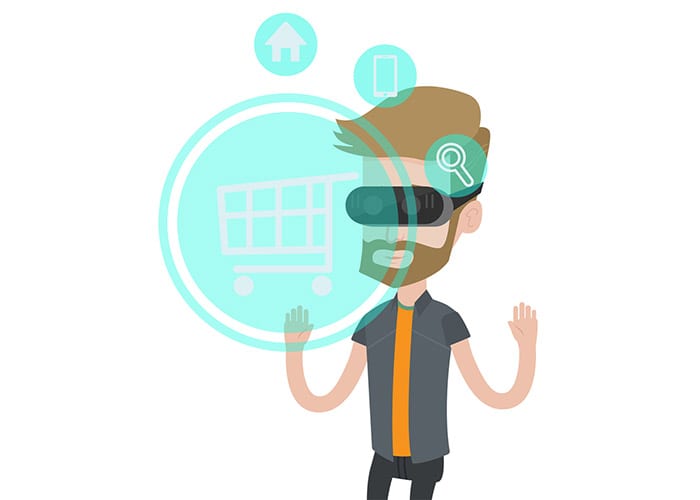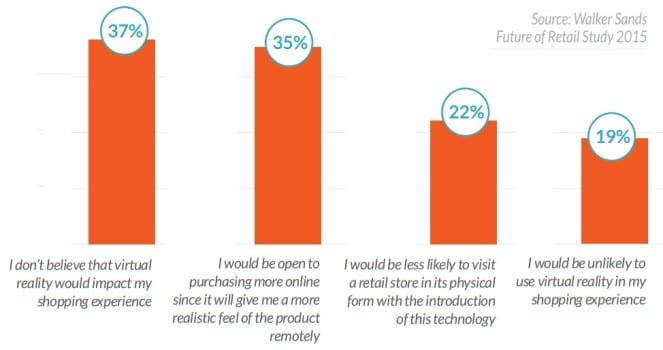Virtual Shopping: The Future Ecommerce Experience

But is this a far-fetched concept for today’s technology? Or should online retailers be gearing up and preparing for the next obvious evolution of e-commerce? Join us as we take a top-to-bottom look at the most recent virtual shopping statistics to identify trends and determine just how realistic virtual reality for e-commerce is in the near future.
Quick Look: The Virtual Shopping Industry
Virtual reality shopping is a small but growing industry that’s being headed by emerging companies (many of which you have most likely have never heard of but will probably know of soon). Artifacia is one of these such companies that is pushing new technologies for the fashion and apparel industries by creating AI that helps shoppers more easily find what they want virtually, while focusing on creating a highly visual e-commerce shopping experience that also suggests new items and images that may intrigue shoppers. It’s AI like this that will become the backbone of the virtual reality in ecommerce, once the user interface has been tested and perfected, of course.
Other innovators, like Mona, deliver virtual shopping assistants that help you create collages, wish lists, shopping lists and more, with convenient sizing apps and a long list of useful functions. For the time being, these two are examples of what the foundation looks like for the future of ecommerce virtual reality, and are merely stepping stones to something that will become ultra-immersive in the years ahead.
About a year ago, the Independent predicted that virtual reality would replace high street shopping by 2050. They cited technologies like the aforementioned being merged with innovative and immersive user interfaces, ultimately culminating into a robust and three-dimensional, virtual shopping experience. Combine these elements with drone package delivery within one hour from the time you placed an order to virtual sizing apps and virtual digital wallets—all technologies that currently exist—and you have the seedlings to birth the next evolution in e-commerce: Virtual Reality.
Brick & Mortar Transitions
The transition of brick and mortar to e-commerce can be somewhat likened to that of the transition that the music industry made when digital formats and downloads made the CD obsolete and volatile. Today, you can’t really find a CD store in any mall, when about 15 years ago, they were in nearly every mall.
Much in the same sense that newspapers have gone digital or bust, such is the same tale and fate of the brick and mortar shopping mall in the near future, as the virtual shopping mall takes its place as the preferred digital destination for shoppers. Already, brick and mortar stores have been hit hard by e-commerce, with thousands of locations closing annually, and some brands vanishing completely. This trend is expected to continue in the wake of virtual shopping.
What Fast Company refers to as Marketplace 3.0, retailers like Amazon, Rakuten, Jet, Alibaba and others are gearing up and are laying the groundwork to shift to virtual shopping. A recent Variety article investigated and came across a job listing for the “Creative Director of Virtual Reality” at Amazon, with the right candidate being described as being: “… passionate about VR and having a strong understanding of what makes a compelling VR experience … extensive understanding of the competitive landscape and global business environment impacting VR, media and entertainment industries.”
Virtual Shopping Malls: The New Brick & Mortar
In what might be the second to last nail in the coffin of brick and mortar is the newly announced Amazon Go stores. They enable virtual grocery shopping with a twist: Shoppers fill up their carts online from any web-enabled device. Then they stop at the local store to simply grab the grocery bags and go. There are no lines, no checkouts, no waits; just easy grocery shopping that’s as fast as it can be. This is an expansion of AmazonFresh, which operates in 16 markets in the U.S. If it takes off, it could become a nationwide trendsetter that puts conventional grocery stores on notice.
Of course, plenty of grocery store chains already offer home delivery, online shopping and no-wait service, like Wal-Mart’s free grocery pickup. But can these stores compete with a trillion-dollar e-commerce giant that’s already been crowned as the reigning king of e-retail?
Early Players in the Virtual Shopping Game
New industry means new players. While the list is rather short at the present, a few virtual shopping apps are out there that offer malls and an individual virtual shopping store. Services like Virtualeshopping let you experience a 3-D mall from your smartphone or VR headset. Another contender, Virtway World, boasts a membership of 100 million users worldwide and creates an enticing platform for brands to offer goods and content on. Meanwhile, one of the earliest entrants, The Virtual Mall, offers a 24/7/365 virtual shopping mall and has a patent date of 2009 on their virtual shopping cart.
What is Virtual Reality Shopping Like?
What would virtual reality shopping be like? Imagine being able to see what an improvement to your home would look like before you even bought any of the items necessary or hired a contractor? This is something that you can already find at Builder Direct, which features virtual home improvements to help you decide.
What about reading the news and being advertised by e-tailers while you are doing so? That’s what you’ll experience with Facebook360. Luxury brands Tommy Hilfiger and Dior already offer virtual shopping, via headset, and Samsung lets you shop from more than 133 stores virtually to make purchases using a digital wallet, evening allowing you to go on virtual cruises for a quick mental escape.
Imagine being in a digital store, where you use your eyes, hands and vocal commands to shop for items. Next, imagine seeing a scan of your body trying on clothing, or seeing what the TV you want looks like in 3-D. As this technology continues to expand, the sky is the limit on how far it can go to enrich the shopping experience.
Virtual Shopping Statistics
While there aren’t that many statistics on virtual shopping currently available, we’ve culled a list of the most recent ones for you using information that was provided in the Walk Sands Future of Retail survey, which polled more than 1,400 respondents from consumer households in the U.S.

- 66% of consumers are interested in virtual reality shopping
- 63% of consumers think that virtual reality will forever change online shopping
- 37% of are open to the idea of virtual shopping in the future
- 49% of consumers would use Oculus Rift to virtually shop
- 32% of consumers are considering purchasing a virtual reality device
- 37% of consumers don’t think virtual reality will change their shopping experience
- 35% of consumers think that virtual reality will encourage them to buy more items
- 22% of consumers won’t visit brick and mortar stores as much with virtual shopping
- 19% of consumers are not interested in virtual shopping at all
Virtual Shopping Infographic
Take a look at this detailed infographic on virtual shopping. It delivers key statistics and metrics that can aid you in your research. Feel free to share, repost and use this image as you see fit, while being kind enough to give us a link back to this blog in the image credits.

Share On:







